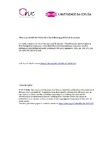Mostrar o rexistro simple do ítem
Parallel JavaScript Execution in Web Navigation Sequences
| dc.contributor.author | Losada Pérez, José | |
| dc.contributor.author | Raposo Santiago, Juan | |
| dc.contributor.author | Pan Bermúdez, Carlos Alberto | |
| dc.contributor.author | Montoto, Paula | |
| dc.contributor.author | Álvarez Díaz, Manuel | |
| dc.date.accessioned | 2023-12-21T15:51:23Z | |
| dc.date.available | 2023-12-21T15:51:23Z | |
| dc.date.issued | 2015-12 | |
| dc.identifier.citation | J. Losada, J. Raposo, A. Pan, P. Montoto and M. Álvarez, "Parallel JavaScript Execution in Web Navigation Sequences," 2015 IEEE/WIC/ACM International Conference on Web Intelligence and Intelligent Agent Technology (WI-IAT), Singapore, 2015, pp. 284-291, doi: 10.1109/WI-IAT.2015.165 | es_ES |
| dc.identifier.isbn | 978-1-4673-9618-9 | |
| dc.identifier.uri | http://hdl.handle.net/2183/34599 | |
| dc.description | © 2015 IEEE. This version of the paper has been accepted for publication. Personal use of this material is permitted. Permission from IEEE must be obtained for all other uses, in any current or future media, including reprinting/republishing this material for advertising or promotional purposes, creating new collective works, for resale or redistribution to servers or lists, or reuse of any copyrighted component of this work in other works. The final published paper is available online at: https://doi.org/10.1109/WI-IAT.2015.165 | es_ES |
| dc.description.abstract | [Abstract]: Web automation applications are widely used for different purposes such as B2B integration and automated testing of web applications. Most current systems build the automatic web navigation component by using the APIs of conventional browsers. This approach suffers performance problems for intensive web automation tasks which require real time responses. Other systems use the approach of creating custom browsers specially designed for web automation. Those browsers can develop some improvements based in the peculiarities of the web automation tasks. In this paper, we present a novel optimization technique that allows the parallel execution of the JavaScript while the navigation component loads the web page. This technique is based in the analysis of the interactions between the scripts during the first loading of the web page, generating some useful information that will be saved and used in the next executions. The tests executed with real web sources show that the scripts contained in the HTML documents can be evaluated concurrently and the navigation component loads the web pages faster when the scripts are executed in parallel. | es_ES |
| dc.language.iso | eng | es_ES |
| dc.publisher | Institute of Electrical and Electronics Engineers | es_ES |
| dc.relation.isversionof | https://doi.org/10.1109/WI-IAT.2015.165 | |
| dc.relation.uri | https://doi.org/10.1109/WI-IAT.2015.165 | es_ES |
| dc.rights | © 2015 IEEE. All rights reserved. Todos os dereitos reservados. | es_ES |
| dc.subject | Web Automation | es_ES |
| dc.subject | Navigation Sequence | es_ES |
| dc.subject | Parallel JavaScript | es_ES |
| dc.subject | Efficient Execution | es_ES |
| dc.title | Parallel JavaScript Execution in Web Navigation Sequences | es_ES |
| dc.type | info:eu-repo/semantics/conferenceObject | es_ES |
| dc.type | info:eu-repo/semantics/conferenceObject | es_ES |
| dc.rights.access | info:eu-repo/semantics/openAccess | es_ES |
| UDC.volume | 3 | es_ES |
| UDC.startPage | 284 | es_ES |
| UDC.endPage | 291 | es_ES |
| dc.identifier.doi | 10.1109/WI-IAT.2015.165 | |
| UDC.conferenceTitle | 2015 IEEE/WIC/ACM International Conference on Web Intelligence and Intelligent Agent Technology (WI-IAT), Singapore, 2015 | es_ES |






